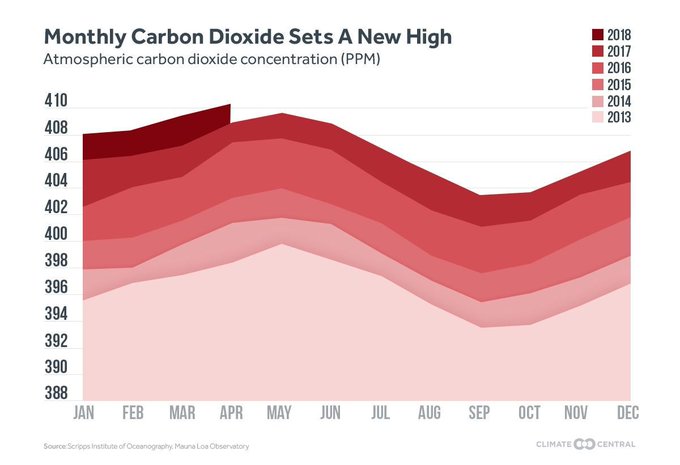As
CO2 Levels Soar Past 'Troubling' 410 ppm Threshold, Trump Kills NASA
Carbon Monitoring Program
What
worries one scientist most is that humanity is "continuing full
speed ahead with an unprecedented experiment with our planet, the
only home we have."
11
May, 2018
As
the Trump administration charges forward with its war on science by
canceling a "crucial"
carbon monitoring system at NASA, scientists and climate experts are
sounding alarms over atmospheric concentrations of carbon dioxide
(CO2) that just surpassed a "troubling"
threshold for the first time in human history.
"The
reading from the Mauna Loa Observatory in Hawaii finds that
concentrations of the climate-warming gas averaged above 410 parts
per million [ppm] throughout April," Chris Mooney wrote for
the Washington
Post. "The
first time readings crossed 410 at all occurred on April 18, 2017, or
just about a year ago."
While
the planet's concentrations of carbon dioxide fluctuated between
roughly 200 ppm and 280 ppm for hundreds of thousands of centuries,
as the NASA chart below
details, CO2 concentrations have soared since the start industrial
revolution—and, without urgent global efforts to significantly
alter human activities that produce greenhouse gas emissions, show no
sign of letting up.

"As
a scientist, what concerns me the most is not that we have passed yet
another round-number threshold but what this continued rise actually
means: that we are continuing full speed ahead with an unprecedented
experiment with our planet, the only home we have," Katharine
Hayhoe, a climate scientist at Texas Tech University, told Mooney.
While
CO2 levels have passed 400 ppm in the Earth's history, "it has
been a long time. And scientists are concerned that the rate of
change now is far faster than what Earth has previously been used
to," as Mooney explained:
In the mid-Pliocene warm period more than 3 million years ago, they were also around 400 parts per million—but Earth's sea level is known to have been 66 feet or more higher, and the planet was still warmer than now.
As a recent federal climate science report (coauthored by Hayhoe) noted, the 400 parts per million carbon dioxide level in the Pliocene "was sustained over long periods of time, whereas today the global CO2 concentration is increasing rapidly." In other words, Earth's movement toward Pliocene-like conditions may play out in the decades and centuries ahead of us.
As
climate scientists continue to warn about
the global consequences of rising levels of CO2 and other greenhouse
gases—such as more intense and frequent extreme
weather events—the
Trump administration has pursued a multi-pronged anti-science agenda
that includes rolling
back regulations
that aim to limit emissions and blocking future research.
On the eve the planet crossed the highest measured CO2 levels, 410 ppm, NASA quietly cancels carbon monitoring research programscience.sciencemag.org/content/360/63…
News
of the record-high levels of atmospheric carbon came
as Science reported that
the Trump administration "quietly killed" NASA's
$10-million-a-year Carbon Monitoring System (CMS), which "has
helped stitch together observations of sources and sinks into
high-resolution models of the planet's flows of carbon"—because,
as 350.org co-founder Bill McKibben remarked sarcastically, "what
you can't see can't cook you."
Trump kills crucial NASA work to measure carbon and methane. Because what you can't see can't cook you. sciencemag.org/news/2018/05/t…
Citing a NASA spokesman, Science explained: "The White House has mounted a broad attack on climate science, repeatedly proposing cuts to NASA's earth science budget, including the CMS, and cancellations of climate missions such as the Orbiting Carbon Observatory 3 (OCO-3). Although Congress fended off the budget and mission cuts, a spending deal signed in March made no mention of the CMS. That allowed the administration's move to take effect."
Canceling
CMS likely has global ramifications, Kelly Sims Gallagher,
director of Tufts University's Center for International Environment
and Resource Policy, pointed out, because the system monitors the
Earth's CO2 levels as nations that have signed on to the Paris
climate agreement—from
which Trump plans
to withdraw—pursue
policies to reduce greenhouse gas emissions.
"If
you cannot measure emissions reductions, you cannot be confident that
countries are adhering to the agreement," Gallagher said,
calling the decision to kill the system "a grave mistake."







No comments:
Post a Comment
Note: only a member of this blog may post a comment.